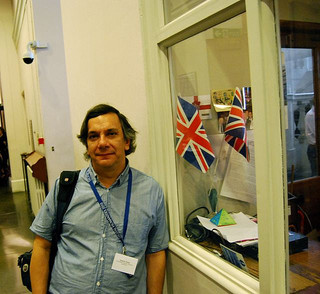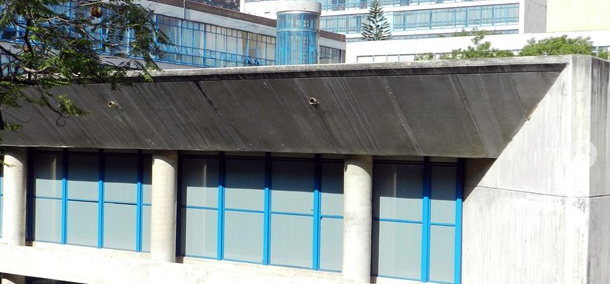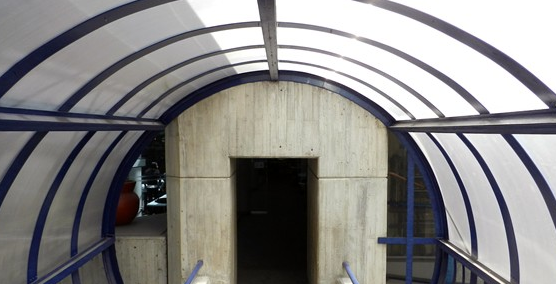
[Para la versión original en español de esta entrevista, favor de hacer clic.]
Ernesto Priani is Vice-Dean of the School of Humanities at UNAM, Mexico, and Vice-President of the Mexican Digital Humanists Network.
Ernesto Priego: Can you tell us who you are, where you do it and how you do it?
Ernesto Priani: At this moment in time it is not easy for me to say who I am. I know it is always difficult, but right now it is even harder for me, because what I once thought I knew well is not what I expected it to be.
Let me say first that I am a philosopher. That as a philosopher I have always been interested in the history of philosophy, particularly in the history of European thought during the Renaissance, and more specifically how the philosophers of that time thought about magic. That interest has now connected with my interest in digital humanities, and particularly with my interest in text encoding as a reading and research strategy strategy, particularly when applied to ancient books.
Nevertheless my interest for the digital humanities does not stop at their development and application within academia. I am convinced that the future of the humanities and its possibilities for survival within academia lies on the adoption of computational technologies and methodologies.
Since the adoption of these technologies in Mexico has been slow (I live in Mexico, which is the country where I live and have developed my career), I decided to actively encourage the acquisition of these tools, by teaching my colleagues and my students, but also by organising those who see themselves as digital humanists through the Red de Humanistas Digitales (Digital Humanists Network), of which I am the Vice-President.
This interest has guided my activity as an academic administrator. I have been the Vice-Dean of the Facultad de Filosofía y Letras (School of Humanities) of my institution, Universidad Nacional Autónoma de México, for a year now. I have promoted activities related to this, not only within my school but as a supervisor of the computing department, whose function we have been able to reconceptualise. As an academic administrator I have also been part of the digital publishing committees of the UNAM’s ITunesU, with whom I have contributed to the design of our institutional digital content creation policies.
So I make the humanist -who keeps making questions about the history of thought, who teaches and does research in this area- coexist with the digital humanist -who teaches and does research using these tools, and who is an advocate of the adoption of new technologies for the humanities.
Ernesto Priego: Every day I find all sorts of opinions that show not only a lack of understanding but a clear distrust of academic work that employs digital methods and tools. What type of obstacles have you faced and how have you overcome them?
Ernesto Priani: The obstacles have been and are still several. I’d like to think that the first one is personal, because one day you realise you are doing things other people do not do, or, if they do them, they do not give them the value that you think they deserve. This puts you in a situation where you are not entirely sure if the path you are taking is the right one. At the end of the day it even makes you wonder if you have not been entirely wrong all along.
I have lived this process with a lot of excitement, the way one experiences risk. But I have also experienced it with a lot of uncertainty. Specially when the obstacles are tangible. One obstacle is when your colleagues and academic and non-academic authorities do not understand what you do. This lack of understanding is often just a lack of will to listen, to understand, to share the work being done. Other times obstacles are true rejections: unsuccessful applications for research funding or for specific programmes or academic recognition.
Personally these obstacles are grounded on the idea that the humanities are composed by a tradition that has already defined them in a closed manner. According to that view, there can be newness and originality in academia, but not innovation.
It is precisely this last concept, innovation, that comes to us from the world of technology, the one that humanists seem not to be prepared to accept, above all because it has an implicit meaning which is deeply disruptive for a community that has devoted itself to foster the opposite: its own preservation. The only way to face this last obstacle has been to debate what the humanities are and to try to introduce into the academic debate this vision of a type of humanities that employs computational methods and tools, just like cards were used in the past to take notes.

I need to point out that in a country with limited resources such as Mexico, an undeniable obstacle has been the lack of available infrastructure, the lack of human and financial resources, and the lack of appropriate facilities. This has always meant that at the start from any digital project one needs to think not only about the project’s development itself, but also about the development of the conditions of its own development in terms of infrastructure, training, human resources, etc.
The way I have personally faced this and the way many others have done it too is by doing small projects that are designed as pedagogical projects, as well as stages or elements of a more complex project that is to be consolidated in the long term. In other words, each small project is like a tiny piece from a bigger jigsaw puzzle.
Ernesto Priego: Tell us about your experience in Hamburg… what is it that stayed with you from the conference and what was your contribution?
Ernesto Priani: It was great. It is a conference I really enjoy not only because I completely belong to it, but because I thought it was incredibly interesting and nurturing, from the academic point of view and also from the perspective of community participation. As usual there were projects and discussions that were highly relevant; I mainly attended those that were closer to my personal projects, on TEI, digital libraries and distant reading tools. Above all it is a conference with a lot of community life; the organisations that organise it do work based on the development of a strong academic community facing challenges and opportunities.
This year I gathered plenty of ideas, particularly those presented around the Agora Project (see also this link), because at the University we are beginning to work in the same direction as that project, and those expressed by Claudine Moulin in the plenary opening lecture about the computing infrastructure for the humanities in the European Union. Also Dino Buzzetti‘s and Manfred Thaller‘s presentations. I also appreciated the specific interest expressed by the ADHO and the ACH, communities to which I belong, for underrepresented communities, especially Latin America and China.
What I contributed: Isabel Galina and I presented a poster about the Red de Humanidades Digitales, a new organisation of digital humanists from Mexico. I believe that through the poster, along with the networking with colleagues, we were able to communicate clearly that something is happening in Mexico, that we have have achieved things that have not been yet developed in other Spanish-speaking countries, and that this makes of Mexico an interesting partner for international organisations.

Ernesto Priego: Some colleagues have recently expressed a kind of tension between theory and digital humanities. Are the digital humanities just a trend of the moment? How are they perceived in Mexico?
Ernesto Priani: This is a very difficult question to answer at this point. Let’s say that in Mexico the concept of the digital humanities is just starting to be promoted and adopted by some sections of the communities that compose the humanities. At the moment, one could say that more than a trend or a well-established field it is a campaign.
A logical question to ask then is: a campaign for what? And the answer, from my personal point of view, is the following: it is simultaneously the introduction of an idea and of a promise.
An idea because it names something it already does -considering that there are already numerous humanities research projects with digital tools- and in the sense that it names, covers and produces meaning. It is a transformation, then, of “secondary” aspects, for example digital tools or products, into a relevant subjects of the first order, and clarifies the activity that some researchers are performing. It is also a promise, because it is hoped that with digital tools the humanities will change in a constructive way. It would be hard for me to say in which way it is hoped it will change.
In Mexico I have not heard, as I have done in international conferences, of the digital humanities making the humanities more like the sciences. I have not heard either of a confrontation between practical humanists and theoretical humanists. The discussion we have had when we have tried to integrate digital humanities subjects within traditional syllabi has taken place between those who see this integration as natural and those who maintain that this should not happen because these subjects are not humanities themes in the strict sense.
In any case, it is still too early to say anything definitive about the digital humanities. In my opinion, the humanities will never be the same again. What we are waiting to see is how long being digital will still be an issue, and when digital resources will become traditional tools.
—
English translation by Ernesto Priego
[Para la versión original en español de esta entrevista, favor de hacer clic.]
One thought on “#RedHD: Interview with Ernesto Priani”